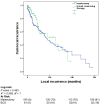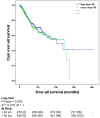Younger age as a prognostic indicator in breast cancer: a cohort study
- PMID: 21871129
- PMCID: PMC3184119
- DOI: 10.1186/1471-2407-11-383
Younger age as a prognostic indicator in breast cancer: a cohort study
Abstract
Background: The debate continues as to whether younger women who present with breast cancer have a more aggressive form of disease and a worse prognosis. The objectives of this study were to determine the incidence of breast cancer in women under 40 years old and to analyse the clinicopathological characteristics and outcome compared to an older patient cohort.
Methods: Data was acquired from a review of charts and the prospectively reviewed GUH Department of Surgery database. Included in the study were 276 women diagnosed with breast cancer under the age of forty and 2869 women over forty. For survival analysis each women less than 40 was matched with two women over forty for both disease stage and grade.
Results: The proportion of women diagnosed with breast cancer under the age of forty in our cohort was 8.8%. In comparison to their older counterparts, those under forty had a higher tumour grade (p = 0.044) and stage (p = 0.046), a lower incidence of lobular tumours (p < 0.001), higher estrogen receptor negativity (p < 0.001) and higher HER2 over-expression (p = 0.002); there was no statistical difference as regards tumour size (p = 0.477). There was no significant difference in overall survival (OS) for both groups; and factors like tumour size (p = 0.026), invasion (p = 0.026) and histological type (p = 0.027), PR (p = 0.031) and HER2 (p = 0.002) status and treatment received were independent predictors of OS CONCLUSION: Breast cancer in younger women has distinct histopathological characteristics; however, this does not result in a reduced survival in this population.
Figures
Similar articles
-
Effect of Age on Breast Cancer Patient Prognoses: A Population-Based Study Using the SEER 18 Database.PLoS One. 2016 Oct 31;11(10):e0165409. doi: 10.1371/journal.pone.0165409. eCollection 2016. PLoS One. 2016. PMID: 27798652 Free PMC article.
-
Breast cancer in young women from a low risk population in Nepal.Asian Pac J Cancer Prev. 2013;14(9):5095-9. doi: 10.7314/apjcp.2013.14.9.5095. Asian Pac J Cancer Prev. 2013. PMID: 24175782
-
Prognostic factors and survival according to tumour subtype in women presenting with breast cancer bone metastases at initial diagnosis: a SEER-based study.BMC Cancer. 2020 Nov 13;20(1):1102. doi: 10.1186/s12885-020-07593-8. BMC Cancer. 2020. PMID: 33187507 Free PMC article.
-
Intermediate HER2 expression is associated with poor prognosis in estrogen receptor-positive breast cancer patients aged 55 years and older.Breast Cancer Res Treat. 2020 Feb;179(3):687-697. doi: 10.1007/s10549-019-05505-4. Epub 2019 Dec 6. Breast Cancer Res Treat. 2020. PMID: 31811505
-
Potential roles of lymphovascular space invasion based on tumor characteristics provide important prognostic information in T1 tumors with ER and HER2 positive breast cancer.Clin Transl Oncol. 2020 Dec;22(12):2275-2285. doi: 10.1007/s12094-020-02369-9. Epub 2020 May 23. Clin Transl Oncol. 2020. PMID: 32447641
Cited by
-
Correlation of the BI-RADS assessment categories of Papua New Guinean women with mammographic parenchymal patterns, age and diagnosis.J Med Radiat Sci. 2020 Dec;67(4):269-276. doi: 10.1002/jmrs.422. Epub 2020 Sep 16. J Med Radiat Sci. 2020. PMID: 32936540 Free PMC article.
-
Retrospective analysis of clinicopathological characteristics and family history data of early-onset breast cancer: a single-institutional study of Hungarian patients.Pathol Oncol Res. 2013 Oct;19(4):723-9. doi: 10.1007/s12253-013-9635-z. Epub 2013 May 26. Pathol Oncol Res. 2013. PMID: 23709114
-
Impact of breast cancer subtypes on 3-year survival among adolescent and young adult women.Breast Cancer Res. 2013;15(5):R95. doi: 10.1186/bcr3556. Breast Cancer Res. 2013. PMID: 24131591 Free PMC article.
-
Perceived cognitive functioning and its influence on emotional vulnerability in breast cancer.Health Psychol Open. 2019 Aug 23;6(2):2055102919871661. doi: 10.1177/2055102919871661. eCollection 2019 Jul-Dec. Health Psychol Open. 2019. PMID: 31489203 Free PMC article.
-
The impact of young age (< 40 years) on the outcome of a cohort of patients with primary non-metastatic breast cancer: analysis of 10-year survival of a prospective study.BMC Cancer. 2022 Jan 3;22(1):27. doi: 10.1186/s12885-021-09100-z. BMC Cancer. 2022. PMID: 34980002 Free PMC article.
References
-
- Swanson GM, Lin CS. Survival patterns among younger women with breast cancer: the effects of age, race, stage, and treatment. J Natl Cancer Inst Monogr. 1994;16:69–77. - PubMed
Publication types
MeSH terms
LinkOut - more resources
Full Text Sources
Medical
Research Materials
Miscellaneous



